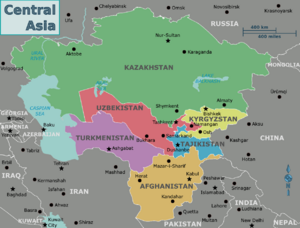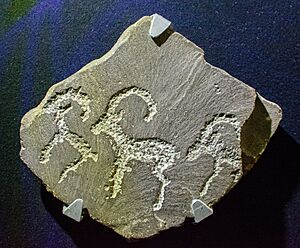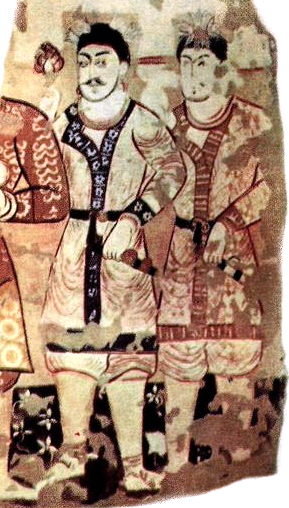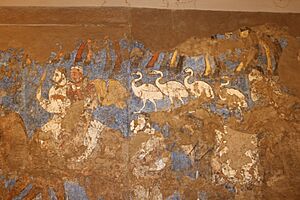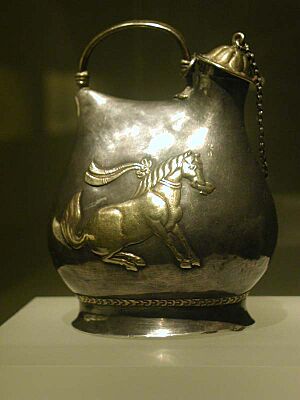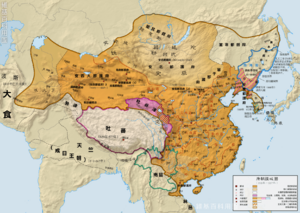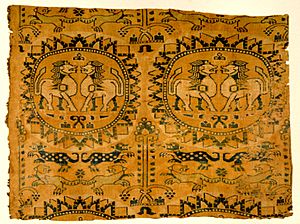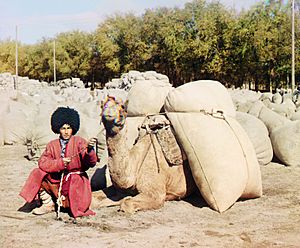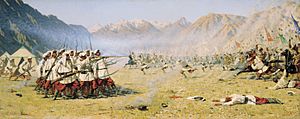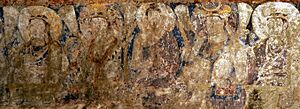History of Central Asia facts for kids
The history of Central Asia is all about the different groups of people who have lived there. Their way of life was shaped by the region's climate and geography. Central Asia is very dry, which makes farming tough. Also, it's far from the sea, so trade was limited. Because of this, not many big cities grew here. For thousands of years, nomadic people who rode horses ruled this area.
These nomads and the settled people living nearby often had conflicts. The nomadic lifestyle was perfect for fighting. Horse riders from the steppes became some of the best warriors in the world. They used powerful techniques with their horse archers. Sometimes, tribal leaders would unite several tribes into a strong army. These armies would then conquer other lands, especially more "civilized" areas. Famous examples include the Huns invading Europe, Turkic groups moving into Transoxiana, and the Mongol conquest of much of Asia and Europe.
The nomads' power ended in the 1500s. This happened when settled people started using firearms. The Russian Empire and the Qing dynasty of China expanded into the region. By the late 1800s, they controlled most of Central Asia. After the Russian Revolution of 1917, the Soviet Union took over most of Central Asia. Only Mongolia and Afghanistan stayed somewhat independent. Mongolia was like a Soviet "satellite state," and Soviet troops even invaded Afghanistan later. The Soviet areas of Central Asia saw a lot of factories built and new roads. But local cultures were also suppressed, and there were lasting problems with ethnic tensions and the environment.
When the Soviet Union broke apart in 1991, five Central Asian countries became independent. These were Kazakhstan, Uzbekistan, Turkmenistan, Kyrgyzstan, and Tajikistan. In most of these new countries, former Communist Party leaders stayed in power. Kyrgyzstan was a bit different. It removed three presidents in popular uprisings, but it still struggles to create a stable democracy.
Contents
Early History of Central Asia
First Humans and Ancient People
Humans arrived in Central Asia about 50,000 to 40,000 years ago. The Tibetan Plateau was reached around 38,000 years ago. The oldest human remains found in northern Central Asia are 45,000 years old. This person was genetically closest to ancient and modern East Asians.
Early Central Asia had a unique population related to Europeans. Later, people from Siberia brought East Asian genes. During the Bronze Age, many groups from Europe and the Middle East moved into Central Asia. These groups were linked to Indo-European people. Bronze Age Central Asia was mostly home to Iranian peoples. Some groups also had Siberian or Uralic origins.
Since the early Iron Age, many East Asian groups moved into Central Asia. This made the region more diverse. Over time, Turkic peoples slowly replaced and mixed with the Iranian-speaking locals. This changed the population of Central Asia from mostly Iranian to mainly East Asian. Modern Central Asians have both West and East Eurasian ancestors. Most are primarily of East Asian descent, linked to the expanding Turkic peoples from Mongolia and Northeast Asia.
Early Cultures and Horse Domestication
The "Ceramic Mesolithic" refers to late Stone Age cultures in Central Asia from 6000 to 4000 BC. These cultures made special pottery, even though they didn't farm. This pottery may have first appeared near Lake Baikal in Siberia.
The Botai culture (around 3700–3100 BC) is believed to be the first to tame the horse. People from the Botai culture had about two-thirds European and one-third East Asian ancestry.
In the Pontic–Caspian steppe, copper-stone age cultures developed in the late 4000s BC. These small communities lived in permanent settlements. They started farming and raising animals. Around this time, some of them began to tame horses. This region is also thought to be where the Indo-European languages began.
The Rise of Nomads
The horse-drawn chariot appeared around 3000 BC. By 2000 BC, war chariots with spoked wheels became common. These chariots were easier to move and ruled battlefields. Horses were used more and more. At the same time, the irrigation systems that allowed farming in the region failed around 2000 BC. This led to the rise of pastoral nomadism by 1000 BC. This way of life would dominate Central Asia for thousands of years, leading to the Scythian expansion in the Iron Age.
Nomadic groups kept herds of sheep, goats, horses, and camels. They moved every year to find new pastures. This practice is called transhumance. These people lived in yurts (or gers). These were tents made of animal hides and wood that could be taken apart and moved. Each group had several yurts, with about five people in each.
While nomads ruled the dry plains, small city-states and farming societies grew in the wetter parts of Central Asia. The Bactria-Margiana Archaeological Complex (early 2000s BC) was the first settled civilization here. They farmed wheat and barley using irrigation. They might have even had a form of writing. Bactria-Margiana likely interacted with the Bronze Age nomads of the Andronovo culture. These nomads invented the spoke-wheeled chariot. They lived north of Bactria-Margiana in Siberia and Kazakhstan.
Later, the strong Sogdian city-states in the Fergana Valley became important. After 100 BC, these cities became stops for traders on the Silk Road. They grew rich from this trade. The steppe nomads relied on these settled people for many goods they couldn't make themselves. Nomads would trade when they could. But since they didn't produce many goods that settled people wanted, they often chose to raid instead.
Many different people lived on the steppes. Nomadic groups included the Huns, other Turks, and Indo-Europeans like the Tocharians, Persians, Scythians, Saka, Yuezhi, Wusun, and various Mongol groups. Even with these different backgrounds, the nomadic lifestyle led to very similar cultures across the region.
Ancient Empires and Central Asia
Empires and Nomadic Resistance

In the 2000s and 1000s BC, large and powerful states grew on the southern edge of Central Asia. These empires tried to conquer the steppe people many times, but with mixed success. The Median Empire and Achaemenid Empire both ruled parts of Central Asia. The Xiongnu Empire (209 BC-156 AD) might be seen as the first Central Asian empire. It set an example for later Turkic and Mongol empires.
Chinese states also often tried to expand their power westward. Despite their strong armies, these states found it hard to conquer the entire region. When faced with a stronger force, the nomads could simply retreat deep into the steppe. They would wait for the invaders to leave. Nomads had no cities or much wealth other than their herds, which they took with them. So, they had nothing that invaders could force them to defend. The Greek historian Herodotus wrote about how the Persian campaigns against the Scythians failed.
Some empires, like the Persian and Macedonian empires, did make deep inroads into Central Asia. They did this by building cities and controlling trade centers. Alexander the Great's conquests spread Hellenistic culture all the way to Alexandria Eschate (meaning "Alexandria the Furthest"). This city was founded in 329 BC in modern Tajikistan. After Alexander died in 323 BC, his Central Asian lands went to the Seleucid Empire.
Trade and Cultural Blending
In 250 BC, the Central Asian part of the Seleucid Empire (Bactria) broke away. It became the Greco-Bactrian Kingdom. This kingdom had strong connections with India and China until it ended in 125 BC. The Indo-Greek Kingdom, mostly in the Punjab region, helped develop Greco-Buddhism. The Kushan Kingdom thrived across a large part of the region from 200 BC to 400 AD. It continued Hellenistic and Buddhist traditions. These states became rich because they were on the Silk Road, which linked China and Europe.
In eastern Central Asia, the Chinese Han dynasty also expanded into the region. From about 115 to 60 BC, Han forces fought the Xiongnu for control of the oasis city-states in the Tarim Basin. The Han eventually won. They set up the Protectorate of the Western Regions in 60 BC to manage defense and foreign affairs. Later, the Kushans and Hephthalites took over Chinese rule in the Tarim Basin.
Other outside powers, like the Sassanid Empire, later controlled this trade. The Parthian Empire was from Central Asia but adopted Persian-Greek cultures. This shows a common pattern in Central Asian history: sometimes nomads from Central Asia would conquer nearby kingdoms, but then quickly blend into the culture of the people they had conquered.
At this time, Central Asia was a diverse region with many cultures and religions. Buddhism was the largest religion, mainly in the east. Near Persia, Zoroastrianism became important. Nestorian Christianity entered the area but was always a minority faith. Manichaeism was more successful and became the third largest religion.
Turkic expansion began in the 500s. The Turkic-speaking Uyghurs were one of many cultural groups brought together by the Silk Road trade at Turfan. Turfan was then ruled by China's Tang dynasty. The Uyghurs were mainly nomadic herders. They followed several religions, including Manichaeism, Buddhism, and Nestorian Christianity. Many ancient items from this period were found in this remote desert region in the 1800s.
Medieval Central Asia
Chinese Influence and Turkic Power
During the Sui and Tang dynasties, China expanded into eastern Central Asia. Chinese foreign policy had to deal with Turkic nomads, who were becoming the most powerful group in Central Asia. To handle the Turks, the Sui government fixed fortifications and welcomed their trade and tribute. They even sent royal princesses to marry Turkic clan leaders four times between 597 and 617. The Sui army also got involved in Turkic civil wars to create conflict among them.
By the Sui dynasty, Turks were a major military force used by the Chinese. In 605, when the Khitans raided northeast China, a Chinese general led 20,000 Turks against them. The Turks were rewarded with Khitan livestock and women. Between 635 and 636, Tang princesses married Turkic mercenaries or generals in Chinese service twice.
Throughout the Tang dynasty, until 755, about ten Turkic generals served under the Tang. Most of the Tang army was made of Chinese conscripts. But most troops led by Turkic generals were not Chinese. They mainly campaigned on the western frontier where Chinese troops were few. Some "Turkic" troops were actually Han Chinese who had adopted nomadic ways.
By 626, civil war in China had mostly ended. The Tang then began to attack the Turks. In 630, Tang armies captured parts of the Ordos Desert, modern Inner Mongolia, and southern Mongolia from the Turks. After this victory, Emperor Taizong was given the title of Great Khan by various Turks who pledged loyalty to him. Thousands of Turks even moved to China to live in Chang'an.
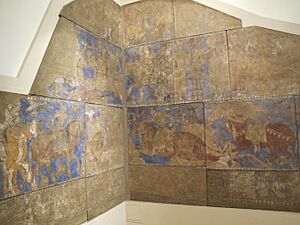
The Tang government aimed to control the central steppe. Like the earlier Han dynasty, the Tang, along with Turkic allies like the Uyghurs, conquered Central Asia in the 640s and 650s. During Emperor Taizong's rule, large campaigns were launched against the Göktürks and other groups. Taizong also attacked the oasis states of the Tarim Basin, starting with the takeover of Gaochang in 640. The nearby kingdom of Karasahr was captured in 644, and Kucha was conquered in 649.
Chinese expansion into Central Asia continued under Emperor Gaozong. He invaded the Western Turks in 657 with an army led by Su Dingfang. The Western Turks were defeated and absorbed into the Tang empire. The territory was managed through the Anxi Protectorate. Tang control beyond the Pamir Mountains in Afghanistan ended with Turkic revolts in 665. But the Tang kept a military presence in Kyrgyzstan, Tajikistan, Uzbekistan, and Kazakhstan. These areas were later invaded by the Tibetan Empire in 670.
Tang vs. Tibet
The Tang Empire and the Tibetan Empire fought for control of Inner and Central Asia. Sometimes, they made peace through marriage alliances, like Princess Wencheng marrying Songtsän Gampo. There were many conflicts with Tibet over lands in the Tarim Basin between 670 and 692. In 763, the Tibetans even captured the Chinese capital, Chang'an, for fifteen days during the An Shi Rebellion. During this rebellion, the Tang pulled back its western garrisons, which Tibet then occupied along with Central Asian territory. Fighting between the Tang and Tibet continued until they signed a peace treaty in 821. The terms of this treaty, including the borders, are written on a stone pillar outside the Jokhang temple in Lhasa.
The Arrival of Islam
In the 700s, Islam began to spread into the region. The desert nomads of Arabia were strong fighters, just like the steppe nomads. The early Arab Empire gained control over parts of Central Asia. Early conquests by Qutayba ibn Muslim (705–715) were soon reversed by local uprisings and an invasion by the Turgesh. But when the Turgesh khaganate collapsed after 738, Muslim rule was re-established.
The Arab invasion also pushed Chinese influence out of western Central Asia. At the Battle of Talas in 751, an Arab army decisively defeated a Tang dynasty force. For the next few centuries, Middle Eastern influences would dominate the region. However, large-scale conversion to Islam didn't begin until the 800s. This happened as the Abbasid empire broke apart and local Iranian and Turkic dynasties, like the Samanids, emerged.
Steppe Empires and Their Impact
The Power of Horsemen
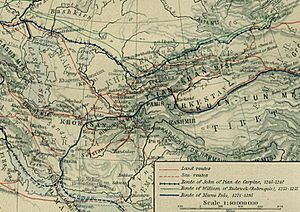
Over time, as new technologies appeared, nomadic horsemen became even more powerful. The Scythians developed the saddle. By the time of the Alans, people started using the stirrup. Horses also grew larger and stronger, so chariots were no longer needed. Horses could carry men easily. This greatly increased how fast nomads could move. It also freed their hands, allowing them to use the bow from horseback.
Using small but powerful composite bows, the steppe people slowly became the strongest military force in the world. From a young age, almost every male was trained in riding and archery. These were necessary skills for survival on the steppe. By adulthood, these activities were second nature. These mounted archers could move faster than any other army at the time. They could easily travel forty miles a day.
The steppe peoples quickly came to rule Central Asia. They forced the scattered city-states and kingdoms to pay them tribute or face destruction. However, the fighting ability of the steppe peoples was limited by their lack of strong political structure. Groups would sometimes form alliances under a ruler called a khan. When many nomads acted together, they could be devastating, like when the Huns arrived in Western Europe. But tradition said that any conquered land should be divided among the khan's sons. So, these empires often fell apart as quickly as they formed.
Rise and Fall of Empires

Once foreign powers were pushed out, several local empires formed in Central Asia. The Hephthalites were the most powerful of these nomad groups in the 500s and 600s. They controlled much of the region. In the 900s and 1000s, the region was divided among several strong states. These included the Samanid dynasty, the Seljuk Turks, and the Khwarezmid Empire.
The most amazing power to rise from Central Asia appeared when Genghis Khan united the tribes of Mongolia. Using excellent military techniques, the Mongol Empire spread to include all of Central Asia and China. It also took over large parts of Russia and the Middle East. After Genghis Khan died in 1227, most of Central Asia continued to be ruled by the Mongol successor state, the Chagatai Khanate. This state didn't last long. In 1369, Timur, a Turco-Mongol ruler, conquered most of the region.
It was even harder to keep a steppe empire together than to conquer lands outside the region. While steppe peoples found it easy to conquer these areas, they found governing them almost impossible. The loose political structure of the steppe alliances was not suited for the complex states of settled peoples. Also, the nomads' armies needed many horses, usually three or four for each warrior. Keeping these forces required large areas of grazing land, which were not found outside the steppe. So, any long time away from their homeland would cause the steppe armies to slowly break apart. To govern settled peoples, the steppe peoples had to rely on local officials. This led to the nomads quickly blending into the culture of those they had conquered. Another limit was that the armies could not easily go into the forested regions to the north. Because of this, states like Novgorod and Muscovy began to grow stronger.
In the 1300s, much of Central Asia and many areas beyond it were conquered by Timur (1336–1405), also known as Tamerlane. During Timur's rule, the nomadic steppe culture of Central Asia mixed with the settled culture of Iran. This led to a new artistic style that celebrated Timur and later Timurid rulers. This style also showed their commitment to Islam. However, Timur's large empire collapsed soon after his death. The region then became divided among smaller khanates, including the Khanate of Khiva, the Khanate of Bukhara, the Khanate of Kokand, and the Khanate of Kashgar.
Modern Changes in Central Asia
End of an Era (1500s-1800s)
The nomadic lifestyle that had existed almost unchanged since 500 BC began to disappear after 1500. Important changes in the world economy in the 1300s and 1400s were due to new sailing technology. Europeans found ocean trade routes. They had been cut off from the Silk Road by Muslim states that controlled its western end. Long-distance trade linking East Asia and India to Western Europe increasingly moved by sea, not through Central Asia. However, Russia's rise as a world power allowed Central Asia to continue as a land trade route, now connecting India with Russia from north to south.
An even more important change was the introduction of gunpowder weapons. The gunpowder revolution allowed settled people to defeat steppe horsemen in open battle for the first time. Building these weapons needed the factories and economies of large societies. Nomadic peoples found it impractical to produce them. The nomads' lands began to shrink. Starting in the 1400s, settled powers slowly began to conquer Central Asia.
The last steppe empire to emerge was that of the Dzungars. They conquered much of East Turkestan and Mongolia. However, they could not match the Chinese and were decisively defeated by the forces of the Qing dynasty. This showed how times had changed. In the 1700s, the Qing emperors, who were originally from the far eastern edge of the steppe, campaigned in the west and in Mongolia. The Qianlong Emperor took control of Xinjiang in 1758. The Mongol threat was overcome, and much of Inner Mongolia was added to China.
One Turko-Mongolic dynasty that remained important was the Mughal Empire. Its founder, Babur, was a descendant of Timur. The Mughals never conquered Babur's original lands in the Fergana Valley, which fell to the Shaybanids. But they kept influence in Afghanistan until the late 1600s, even as they ruled India. After the Mughal Empire declined in the 1700s, the Durrani Empire from Afghanistan briefly took over northwestern India. By the 1800s, the rise of the British Empire limited the impact of Afghan conquerors.
The Chinese lands stretched into the heart of Central Asia and included the Khanate of Kokand, which paid tribute to Beijing. Outer Mongolia and Xinjiang did not become provinces of the Chinese empire. Instead, they were directly managed by the Qing dynasty. Because there was no provincial governor, local rulers kept most of their powers. This special status also prevented people from the rest of China from moving into the region. Persia also began to expand north, especially under Nadir Shah, who extended Persian rule far past the Oxus River. However, after his death, the Persian empire quickly fell apart.
Russian Expansion and the Great Game
The Russians also expanded south. First, they turned the Ukrainian steppe into farmland. Then, they moved onto the edge of the Kazakh steppes, starting with the fortress of Orenburg. The slow Russian conquest of Central Asia began in the early 1800s. However, Peter the Great had sent a failed expedition against Khiva as early as the 1720s.
By the 1800s, local people could do little to stop the Russian advance. Although the Kazakhs of the Great Horde, led by Kenesary Kasimov, rebelled from 1837 to 1846. Until the 1870s, Russian involvement was mostly minimal. They left local ways of life and government structures in place. After conquering Turkestan in 1865 and securing the border, the Russians gradually took large parts of the steppe. They gave these lands to Russian farmers, who began to arrive in large numbers. This process first happened on the northern edges of the steppe. It was only in the 1890s that many Russians began to settle further south, especially in Zhetysu (Semirechye).
The main opposition to Russian expansion into Turkestan came from the British. They felt that Russia was becoming too powerful and threatening the northwest borders of British India. This rivalry was known as The Great Game. Both powers competed to advance their interests in the region. This rivalry did little to slow the pace of conquest north of the Oxus River. But it did ensure that Afghanistan remained independent as a "buffer state" between the two Empires.
After General Cherniaev captured Tashkent in 1865, Khodjend, Djizak, and Samarkand quickly fell to the Russians over the next three years. The Khanate of Kokand and the Emirate of Bukhara were repeatedly defeated. In 1867, the Governor-Generalship of Russian Turkestan was set up under General Konstantin Petrovich Von Kaufman, with its main office in Tashkent. From 1881–85, the Transcaspian region was added to Russia. This happened during a campaign led by Generals Mikhail Annenkov and Mikhail Skobelev. Ashkhabad (from Persia), Merv, and Pendjeh (from Afghanistan) all came under Russian control.
Russian expansion stopped in 1887 when Russia and Great Britain marked the northern border of Afghanistan. Bukhara and the Khanate of Khiva remained somewhat independent. But they were essentially "protectorates," similar to the Princely States of British India. Although the conquest was mainly for military reasons, in the 1870s and 1880s, Turkestan became quite important economically within the Russian Empire.
Because of the American Civil War, cotton prices shot up in the 1860s. Cotton became a very important product in the region, though it was grown on a much smaller scale than during the Soviet period. The cotton trade led to improvements. The Transcaspian Railway from Krasnovodsk to Samarkand and Tashkent, and the Trans-Aral Railway from Orenburg to Tashkent were built. In the long run, growing only cotton would make Turkestan dependent on food imports from Western Siberia. The Turkestan-Siberia Railway was already planned when First World War broke out.
Russian rule remained distant from the local people. It mostly focused on the small number of Russian inhabitants in the region. Local Muslims were not considered full Russian citizens. They did not have all the rights of Russians, but they also didn't have the same duties, like military service. The Tsarist government left many parts of the old systems in place, such as Muslim religious courts. Local self-government at the village level was quite extensive.
China's Role and Revolts
During the 1600s and 1700s, the Qing dynasty made several campaigns to conquer the Dzungar Mongols. At the same time, they added parts of Central Asia to the Chinese Empire. Internal problems mostly stopped Chinese expansion in the 1800s. In 1867, Yakub Beg led a rebellion. Kashgar declared its independence. The Taiping and Nian Rebellions in the heart of the empire prevented the Chinese from regaining control.
Instead, the Russians expanded. They took the Chu and Ili Valleys and the city of Kuldja from the Chinese Empire. After Yakub Beg died in Korla in 1877, his state collapsed. China then reconquered the area. After long talks, Kuldja was returned to Beijing by Russia in 1884.
Revolution and Independence Movements
During the First World War, the Russian government removed the rule that exempted Muslims from military service. This sparked the Central Asian Revolt of 1916. When the Russian Revolution of 1917 happened, a temporary government of Jadid Reformers, also called the Turkestan Muslim Council, met in Kokand. They declared Turkestan's independence. This new government was quickly crushed by the forces of the Tashkent Soviet. The semi-independent states of Bukhara and Khiva were also invaded. The main independence forces were quickly defeated. But guerrillas known as basmachi continued to fight the Communists until 1924. Mongolia was also affected by the Russian Revolution. Though it never became a Soviet republic, it became a communist People's Republic in 1924.
The creation of the Republic of China in 1911 and the general chaos in China affected the Qing dynasty's lands in Central Asia. The Republic of China's control of the region was limited to southern Xinjiang. There was a double threat from Islamic separatists and communists. Eventually, the region became largely independent under the control of the provincial governor. Instead of invading, the Soviet Union set up consulates in the region and sent aid and technical advisors.
By the 1930s, the governor of Xinjiang's relationship with Moscow was much more important than with Nanking. The Chinese Civil War further destabilized the region. Turkic nationalists tried to gain independence. In 1933, the First East Turkestan Republic was declared. But it was soon destroyed with the help of Soviet troops.
After Germany invaded the Soviet Union in 1941, Governor Sheng Shicai of Xinjiang took a risk. He broke his ties to Moscow and allied with the Kuomintang. This led to a civil war in the region. Sheng was eventually forced to flee. The Soviet-backed Second East Turkistan Republic was formed in northern Dzungaria, while the Republic of China kept control of southern Xinjiang. Both states were taken over by the People's Republic of China in 1949.
Central Asia Under Soviet Rule (1918–1991)
After being conquered by Bolshevik forces, Soviet Central Asia went through many administrative changes. In 1918, the Bolsheviks set up the Turkestan Autonomous Soviet Socialist Republic. Bukhara and Khiva also became SSRs (Soviet Socialist Republics). In 1919, the Conciliatory Commission for Turkestan Affairs was created to improve relations between locals and Communists. New policies were introduced that respected local customs and religion. In 1920, the Kirghiz Autonomous Soviet Socialist Republic, covering modern Kazakhstan, was set up. It was renamed the Kazakh Autonomous Soviet Socialist Republic in 1925. In 1924, the Soviets created the Uzbek SSR and the Turkmen SSR. In 1929, the Tajik SSR was separated from the Uzbek SSR. The Kyrgyz Autonomous Oblast became an SSR in 1936.
These borders had little to do with ethnic groups. But the Soviets felt it was important to divide the region. They saw both Pan-Turkism (a movement to unite all Turkic peoples) and Pan-Islamism (a movement to unite all Muslims) as threats. Dividing Turkestan would limit these movements. Under the Soviets, local languages and cultures were organized and written down. Their differences were clearly marked and encouraged. New Cyrillic writing systems were introduced to break ties with Turkey and Iran. Under the Soviets, the southern border was almost completely closed. All travel and trade were directed north through Russia.
During the forced collectivization under Joseph Stalin, at least a million people died, mostly in the Kazakh SSR. Islam, as well as other religions, were also attacked. In the Second World War, several million refugees and hundreds of factories were moved to the relative safety of Central Asia. The region permanently became an important part of the Soviet industrial system. Several important military sites were also in the region, including nuclear testing facilities and the Baikonur Cosmodrome. The Virgin Lands Campaign, starting in 1954, was a huge Soviet farming program. It brought over 300,000 people, mostly from Ukraine, to northern Kazakh SSR and the Altai region of Russia. This greatly changed the ethnic makeup of the region.
Similar things happened in Xinjiang and the rest of Western China. The PRC quickly took control from the Second East Turkestan Republic (which controlled northern Xinjiang) and the Republic of China forces (which controlled southern Xinjiang) after the Qing dynasty. The area had many development plans. Like Soviet Central Asia, one focus was on growing cotton. These efforts were managed by the Xinjiang Production and Construction Corps. This group also encouraged Han Chinese to return to Xinjiang after many had left during the Muslim revolts against the Qing dynasty.
Political unrest led to major population changes in the region. During the Qing dynasty, Xinjiang was 60% Turkic and 30% Han Chinese. After the Muslim revolts, the percentage of Han Chinese dropped to as low as 7%. By the year 2000, about 40% of Xinjiang's population was Han Chinese. As with the Soviet Union, local languages and cultures were mostly encouraged, and Xinjiang was given autonomous status. However, Islam was greatly persecuted, especially during the Cultural Revolution. Many people from other parts of China fled to Xinjiang due to the failed farming policies of the Great Leap Forward in other provinces. However, the Great Leap Forward did not affect much of Xinjiang due to its geographical isolation from other parts of China.
World War II and Population Shifts
World War II caused many Soviet citizens to move to the back areas of the USSR. Much of this movement was directed to Soviet Central Asia. These migrations included official, state-organized evacuations and deportations. There was also unplanned, panicked flight from the front by both regular citizens and important officials. Moving Soviet citizens and industries during World War II was key to their overall success in the war. Central Asia served as a main destination for those being moved.
The German invasion of the Soviet Union began on June 22, 1941. A rule from the government on the same day banned entry or exit from the USSR's border regions, which were under martial law. Such rules showed the Soviets' fear of spreading panic. They also showed their commitment to directly control wartime moves to keep order. Soviet wartime population policy had two main parts: deportation and evacuation. Deportation aimed to clear regions near the front of potentially harmful anti-Soviet people who could hurt the war effort. Evacuation policy aimed to move Soviet industry and smart people to safer areas in the back.
Around 12 million Soviet citizens were successfully moved in 1941, and another 4.5 million were moved the next year. Also, the factories that were successfully moved to Central Asia helped provide the production capacity the Soviets needed to eventually win the war. This also prevented the Germans from getting more industrial resources. By providing a safe place from the German advance for Soviet citizens, Central Asia played a critical role in helping the Allies win the war.
Central Asia Since 1991
From 1988 to 1992, a free press and multiple political parties developed in the Central Asian republics. This happened as "perestroika" (changes in the Soviet Union) pushed local Communist parties to open up. This "Central Asian Spring" was very short-lived. Soon after independence, former Communist Party officials became local strongmen. Political stability in the region has mostly been kept. A major exception was the Tajik Civil War that lasted from 1992 to 1997. In 2005, the Kyrgyz president Askar Akayev was largely peacefully removed in the Tulip Revolution. There was also an outbreak of violence in Andijan, Uzbekistan.
Most people in Soviet Central Asia didn't care much about the collapse of the Soviet Union. This included the large Russian populations in Kazakhstan (about 40% of the total) and Tashkent, Uzbekistan. Aid from Moscow had also been central to Central Asia's economies. Each republic received huge amounts of money from Moscow.
Independence largely came from the efforts of small groups of nationalistic, mostly local intellectuals. Moscow also had little interest in keeping the expensive region. While never part of the Soviet Union, Mongolia followed a similar path. Often acting as the unofficial sixteenth Soviet republic, it shed the communist system only in 1996. But it quickly ran into economic problems.
The region's economic performance since independence has been mixed. It has some of the world's largest natural resources. But there are big problems in transporting them. Since it is farther from the ocean than anywhere else in the world, and its southern borders were closed for decades, the main trade routes and pipelines run through Russia. As a result, Russia still has more influence over the region than in any other former Soviet republic. However, the rising importance of energy from the Caspian Sea means the US is getting more involved in the region.
Other powers are increasingly getting involved in Central Asia. Soon after the Central Asian states became independent, Turkey began to look east. Several organizations are trying to build links between the western and eastern Turks. Iran, which had close ties with the region for thousands of years, has also been working to build connections. The Central Asian states now have good relations with the Islamic Republic. One important player in the new Central Asia has been Saudi Arabia. It has been funding the Islamic revival in the region. Soon after independence, Saudi money paid for many Qur'ans to be sent to the region. It also funded the building and repair of many mosques. In Tajikistan alone, an estimated 500 mosques per year have been built with Saudi money.
The former atheist Communist Party leaders have mostly converted to Islam. Small Islamist groups have formed in several countries. But radical Islam has little history in the region. Central Asian societies have remained largely secular. All five states have good relations with Israel. Central Asia is still home to a large Jewish population. The largest group is the Bukharan Jews. Important trade and business links have developed between those who left for Israel after independence and those who remained.
The People's Republic of China sees the region as an important future source of raw materials. Most Central Asian countries are members of the Shanghai Cooperation Organisation. This has affected Xinjiang and other parts of western China. They have seen infrastructure programs building new links and also new military facilities. Chinese Central Asia has been far from the center of that country's economic boom. The area has remained much poorer than the coast. China also sees a threat in the potential of the new states to support separatist movements among its own Turkic minorities.
One important Soviet legacy that has only slowly been understood is the huge environmental damage. Most notable is the gradual drying of the Aral Sea. During the Soviet era, it was decided that traditional crops like melons and vegetables would be replaced by water-intensive cotton for Soviet textile mills. Massive irrigation efforts were launched. These diverted a large percentage of the water flowing into the sea, causing it to shrink steadily. Also, vast areas of Kazakhstan were used for nuclear testing. There are also many old, crumbling factories and mines.
In early 2008, Central Asia faced a severe energy crisis. There was a shortage of both electricity and fuel. This was made worse by unusually cold temperatures, failing infrastructure, and a shortage of food. Aid from the west began to help the region.
As of 2019, despite its common culture and history, Central Asia has been "one of the least integrated regions in the world."
Images for kids
See also
 In Spanish: Historia de Asia Central para niños
In Spanish: Historia de Asia Central para niños
- Eurasian nomads
- Eurasian Steppe
- History of Afghanistan
- History of Kazakhstan
- History of Kyrgyzstan
- History of Mongolia
- History of Tajikistan
- History of the central steppe
- History of Turkmenistan
- History of Uzbekistan
- History of Xinjiang


